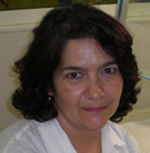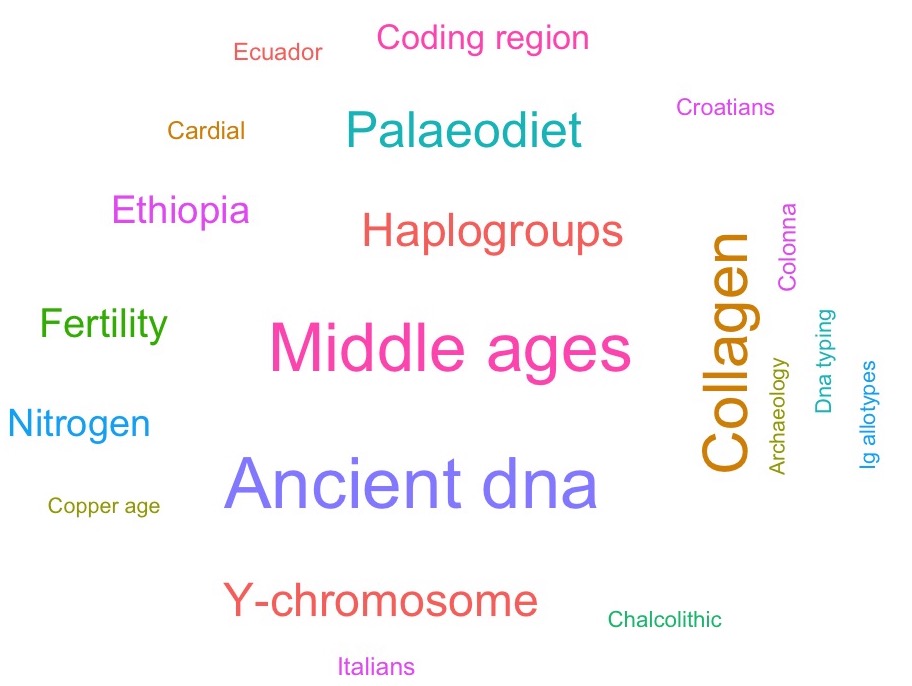 Associate Professor of Anthropology
Associate Professor of Anthropology
Department of Biology
Laboratory of Anthropology
Tel. 06-7259-4348
e-mail: martine@uniroma2.it
Latest publications
- 2020 – Erratum: A multidisciplinary approach to investigate the osteobiography of the Roman Imperial population from Muracciola Torresina (Palestrina, Rome, Italy) – Journal of Archaeological Science: Reports – 10.1016/j.jasrep.2020.102279
- 2020 – The edge of the Empire: diet characterization of medieval Rome through stable isotope analysis – Archaeological and Anthropological Sciences – 10.1007/s12520-020-01158-3
- 2020 – Concerted variation of the 3′ regulatory region of Ig heavy chain and Gm haplotypes across human continental populations – American Journal of Physical Anthropology – 10.1002/ajpa.24011
- 2020 – Leopoli-Cencelle (9th–15th centuries CE), a centre of Papal foundation: bioarchaeological analysis of the skeletal remains of its inhabitants – Annals of Human Biology – 10.1080/03014460.2020.1808064
- 2020 – Back to the roots: dental calculus analysis of the first documented case of coeliac disease – Archaeological and Anthropological Sciences – 10.1007/s12520-019-00962-w
- 2020 – A multidisciplinary approach for investigating dietary and medicinal habits of the Medieval population of Santa Severa (7th-15th centuries, Rome, Italy) – PLoS ONE – 10.1371/journal.pone.0227433
- 2019 – Assessing DNA recovery from highly degraded skeletal remains by using silica-based extraction methods – Forensic Science International: Genetics Supplement Series – 10.1016/j.fsigss.2019.10.204
- 2019 – A multidisciplinary approach to investigate the osteobiography of the Roman Imperial population from Muracciola Torresina (Palestrina, Rome, Italy) – Journal of Archaeological Science: Reports – 10.1016/j.jasrep.2019.101960
- 2019 – Eneolithic subsistence economy in Central Italy: first dietary reconstructions through stable isotopes – Archaeological and Anthropological Sciences – 10.1007/s12520-019-00789-5
- 2019 – Effect of Neolithic transition on an Italian community: Mora Cavorso (Jenne, Rome) – Archaeological and Anthropological Sciences – 10.1007/s12520-018-0615-9
- 2019 – The medieval population of Leopoli-Cencelle (Viterbo, Latium): Dietary reconstruction through stable isotope analysis from bone proteins – Journal of Archaeological Science: Reports – 10.1016/j.jasrep.2018.12.013
- 2019 – Sex selection in late Iberian infant burials: Integrating evidence from morphological and genetic data – American Journal of Human Biology – 10.1002/ajhb.23204
- 2019 – CYP1A1 variability in human populations – Collegium Antropologicum
- 2019 – First analysis of ancient burned human skeletal remains probed by neutron and optical vibrational spectroscopy – Science Advances – 10.1126/sciadv.aaw1292
- 2018 – Methodology for y Chromosome Capture: A complete genome sequence of y chromosome using flow cytometry, laser microdissection and magnetic streptavidin-beads – Scientific Reports – 10.1038/s41598-018-27819-x
- 2018 – Mitochondrial characterisation of two Spanish populations from the Vera and Bejar valleys (Central Spain) – Annals of Human Biology – 10.1080/03014460.2018.1559355
- 2018 – Reconstruction of human subsistence and husbandry strategies from the Iberian Early Neolithic: A stable isotope approach – American Journal of Physical Anthropology – 10.1002/ajpa.23622
- 2018 – Who were the miners of Allumiere? A multidisciplinary approach to reconstruct the osteobiography of an Italian worker community – PLoS ONE – 10.1371/journal.pone.0205362
- 2018 – Dental calculus reveals diet habits and medicinal plant use in the Early Medieval Italian population of Colonna – Journal of Archaeological Science: Reports – 10.1016/j.jasrep.2018.05.023
- 2018 – Bioarchaeological approach to the study of the medieval population of Santa Severa (Rome, 7th–15th centuries) – Journal of Archaeological Science: Reports – 10.1016/j.jasrep.2017.12.043
- 2018 – Mitochondrial variability in the Mediterranean area: a complex stage for human migrations – Annals of Human Biology – 10.1080/03014460.2017.1416172
- 2017 – Comparison of two different DNA extraction methodologies for critical bone or teeth samples – Forensic Science International: Genetics Supplement Series – 10.1016/j.fsigss.2017.09.110
- 2017 – Sex molecular diagnosis on critical samples: Comparison of different methodologies – Forensic Science International: Genetics Supplement Series – 10.1016/j.fsigss.2017.09.168
- 2017 – Genetic characterization and determination of the number of individuals by molecular analysis in a prehistoric finding – Forensic Science International: Genetics Supplement Series – 10.1016/j.fsigss.2017.09.187
- 2017 – The genetic landscape of Serbian populations through mitochondrial DNA sequencing and non-recombining region of the y chromosome microsatellites – Collegium Antropologicum
- 2017 – Bight of Benin: a Maternal Perspective of Four Beninese Populations and their Genetic Implications on the American Populations of African Ancestry – Annals of Human Genetics – 10.1111/ahg.12186
- 2017 – Linking between genetic structure and geographical distance: Study of the maternal gene pool in the Ethiopian population – Annals of Human Biology – 10.3109/03014460.2016.1155646
- 2016 – Archaeo-biological reconstruction of the Italian medieval population of Colonna (8th–10th centuries CE) – Journal of Archaeological Science: Reports – 10.1016/j.jasrep.2016.11.013
- 2016 – Exploring the mitochondrial DNA variability of the Amazonian Yanomami – American Journal of Human Biology – 10.1002/ajhb.22877
- 2016 – Characterisation of genetic structure of the Mayan population in Guatemala by autosomal STR analysis – Annals of Human Biology – 10.3109/03014460.2015.1069891
- 2016 – Grapevine carpological remains revealed the existence of a Neolithic domesticated Vitis vinifera L. specimen containing ancient DNA partially preserved in modern ecotypes – Journal of Archaeological Science – 10.1016/j.jas.2016.04.014
- 2016 – Variability and distribution of COL1A2 (type i collagen) polymorphisms in the central-eastern Mediterranean Basin – Annals of Human Biology – 10.3109/03014460.2015.1006679